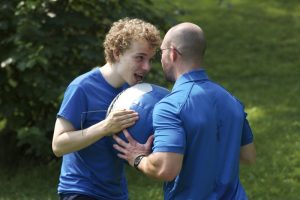 “Okay, I have some Dynamax balls, some resistance bands, a few Sandballs, what do you want to try first?” This is usually my first question after I’ve met a new athlete and I begin the PAC Profile assessment. I want to know if there is any particular piece of equipment or movement pattern that they gravitate towards. Yes I want to optimize squatting patterns and trunk stability, and that will occur over time with patience and consistency. The objective within the first few sessions is developing an amiable repoire with the athlete and introducing new activities.
“Okay, I have some Dynamax balls, some resistance bands, a few Sandballs, what do you want to try first?” This is usually my first question after I’ve met a new athlete and I begin the PAC Profile assessment. I want to know if there is any particular piece of equipment or movement pattern that they gravitate towards. Yes I want to optimize squatting patterns and trunk stability, and that will occur over time with patience and consistency. The objective within the first few sessions is developing an amiable repoire with the athlete and introducing new activities.
Phase 1 is about increasing adaptive functioning. On rare occasion an athlete is either highly motivated to engage in most or all of the activities, or at least compliant enough (I’ve work with athletes who are overeager to please an instructor and receive praise) to participate for the full duration of the exercise or session. Phase 1 is tempering. As a coaches and instructors we can get our athletes more capable, but it requires a buy-in on their part. I’ve no interest in regularly forcing an athlete through a session. It isn’t sustainable over time and if the goal is for fitness to serve as part of long-term programming, there is a mighty advantage to the enjoyment factor being high.
Phase II is about increasing physical aptitude and balancing exercise variety with consistency. There is a significant difference between having two or three variations of five movement patterns and having twenty different activities. Variety is important, however independent mastery of each exercise and movement pattern. With my cognitively higher functioning (and verbal) athletes, I sometimes encounter “Can we do something new?” We certainly can, and that something new does not have to be unnecessarily progressing an activity (going from squats to jumping squats when the squat is not yet mastered).
Doing something “new” can include tweaking current exercises. Maybe taking a scoop throw and performing it with one hand, or bear walks backwards or sideways (can be done with crawls as well), changing the order or activities, or giving the athlete a few minutes to create their own obstacle/exercise course. I should note that it is also a regular follow-up to “Can we do something new?” for me to say “Sure, what do you want to do?” and receive the directive “I don’t know.” Sometimes autonomy needs a little guidance. Even changing around the layout of the equipment or where you perform certain activities can have that refreshment effect. Sometimes my athletes just want to walk around with a Sandbell on their head.
 In Phase II our athletes are accumulating experience and skill. It is still a discovery aspect, and this is where we find the “click” factor; where two or three or four exercises they have been practicing for about two months enter mastery territory and the individual can progress. Phase II is a lot of “I didn’t know he/she could do that” when all that was needed we’re the proper exercise regressions and consistency.
In Phase II our athletes are accumulating experience and skill. It is still a discovery aspect, and this is where we find the “click” factor; where two or three or four exercises they have been practicing for about two months enter mastery territory and the individual can progress. Phase II is a lot of “I didn’t know he/she could do that” when all that was needed we’re the proper exercise regressions and consistency.
Phase III brings expectation and input. The athlete is familiar with all of the different exercises and may initiate some of them on his or her own. I have athletes who will march into the session, pick up a Sandbell, and proceed to touch each cone. Phase III, which in my experience with the ASD population takes anywhere from 3-6 months depending on the level of adaptive ability. At this point the athlete is familiar with the instructor/coach, the names of focus activities, the performance of each (even if not to mastery standards), and confidence in access to reinforcers. At this point secondary reinforcers are usually relegated to breaks between exercises or access to a preferred activity.
Maintaining consistency, providing behavior-specific praise, and using appropriately progressed or regressed exercises are instrumental to increasing motivation. When frustration sets in, and it will, consider the broad perspective that we want fitness programming enjoyable enough that it will stick over a lifetime.
Eric Chessen, M.S., is the Founder of Autism Fitness. An Exercise Physiologist with an extensive background in Applied Behavior Analysis, Eric provides on-site and distance consulting worldwide. He is the creator of the Autism Fitness Toolbox available at AutismFitnessToolbox.com
